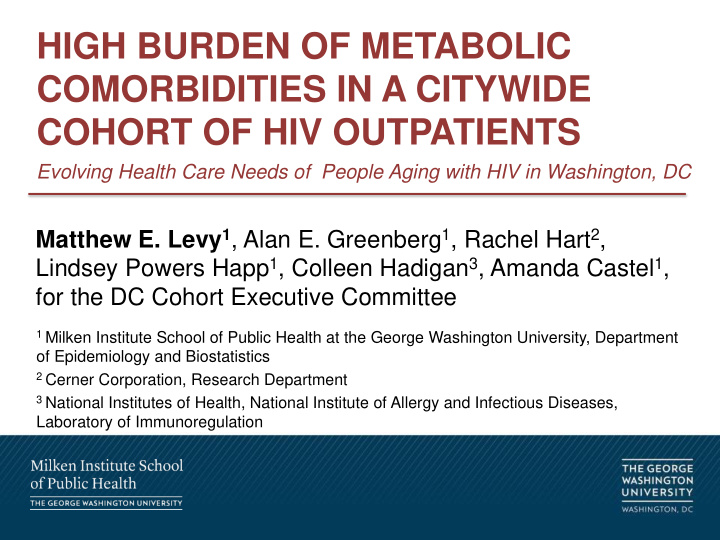



HIGH BURDEN OF METABOLIC COMORBIDITIES IN A CITYWIDE COHORT OF HIV OUTPATIENTS Evolving Health Care Needs of People Aging with HIV in Washington, DC Matthew E. Levy 1 , Alan E. Greenberg 1 , Rachel Hart 2 , Lindsey Powers Happ 1 , Colleen Hadigan 3 , Amanda Castel 1 , for the DC Cohort Executive Committee 1 Milken Institute School of Public Health at the George Washington University, Department of Epidemiology and Biostatistics 2 Cerner Corporation, Research Department 3 National Institutes of Health, National Institute of Allergy and Infectious Diseases, Laboratory of Immunoregulation
Background • 1.5-2-fold increased risk of cardiovascular disease in HIV-infected populations • Availability of population-level prevalence estimates for predisposing metabolic comorbidities will be increasingly important • Burden of metabolic risk factors is not well- characterized in older HIV-infected populations
Objectives 1. Determine prevalence of hypertension, type 2 diabetes, dyslipidemia, and obesity in a large representative sample of HIV outpatients in Washington, DC 2. Examine differences in prevalence by age, sex, and race/ethnicity 3. Assess clinical correlates of these metabolic abnormalities
Methods • Included participants from the DC Cohort study: an ongoing, prospective, multi-center, observational cohort study of HIV outpatients at 13 clinical sites in DC • Routinely monitored and abstracted data in outpatient medical record systems into central database • Conducted secondary cross-sectional analysis of participants ≥18 years old enrolled between 2011 -2015
Variable Definitions • Hypertension : (a) ICD-9, (b) antihypertensive, or (c) BP ≥ 140/90 mm Hg on ≥2 occasions • Type 2 Diabetes : (a) ICD-9, (b) anti-diabetes medication, or (c) either serum glucose ≥200 mg/ dL or HbA1c ≥6.5% on ≥2 occasions (fasting or non-fasting) • Dyslipidemia : (a) ICD-9, (b) lipid-lowering therapy, or (c) either total cholesterol ≥200 mg/ dL or HDL-C <40 mg/dL on ≥1 occasion (fasting or non-fasting) • Obesity : (a) ICD- 9 or (b) BMI ≥30 on ≥1 occasion
Patient Characteristics (n=7,018) % Age (median, IQR) 50 (39-57) Age ≥60 18% Male sex at birth 73% Non-Hispanic black 77% ARV Exposed 97% PI-based regimen 50% Smoking history (current/previous) 63% Receipt of primary care at site 74%
Overall Prevalence 60 49.8% 48.0% 45.6% 50 Prevalence (%) 35.2% 40 30 20 12.9% 10 0 Hypertension Type 2 Obesity Dyslipidemia Multimorbidity Diabetes
Prevalence by Age Group 60-69: 74.1% 100 ≥70: 86.1% 60-69: 66.0% 90 60-69: 68.1% ≥70: 77.5% ≥70: 74.2% 80 Prevalence (%) 70 60 50-59 60-69: 31.1% 50 ≥70: 23.9% 60-69: 24.4% 60-69 ≥70: 28.7% 40 70+ 30 20 10 0 Hypertension Type 2 Obesity Dyslipidemia Multimorbidity Diabetes All p<0.001
Prevalence by Sex 60 50 Prevalence (%) 40 30 Male Female 20 10 0 Hypertension Type 2 Obesity Dyslipidemia Multimorbidity Diabetes p<0.001 for all except hypertension
Prevalence by Race/Ethnicity 70 60 Non- Prevalence (%) 50 Hispanic Black 40 Non- 30 Hispanic White 20 Hispanic 10 0 Hypertension Type 2 Diabetes Obesity Dyslipidemia Multimorbidity All p<0.001
Proportions of Patients with Comorbidities Who Lacked Evidence of Treatment • Hypertension: 38% • Diabetes: 40% • Dyslipidemia (excluding HDL- dyslipidemia) : 56%
Correlates of Metabolic Comorbidities Hypertension Type 2 Diabetes Dyslipidemia Obesity OR (95% CI) OR (95% CI) OR (95% CI) OR (95% CI) Time since HIV 1.01 (1.00, 1.02) * 1.01 (1.00, 1.02) * 1.00 (1.00, 1.01) 1.00 (0.99, 1.01) diagnosis Time on PI- 1.11 (1.09, 1.14) *** 0.98 (0.96, 1.00) 1.01 (0.99, 1.04) 1.01 (0.98, 1.04) based regimen Time on NNRTI- 1.09 (1.06, 1.12) *** 0.95 (0.93, 0.98) *** 1.03 (1.01, 1.06) ** 1.01 (0.97, 1.04) based regimen Time on any 1.07 (1.04, 1.11) *** 0.95 (0.92, 0.98) ** 1.05 (1.01, 1.08) ** 1.04 (1.00, 1.08) other regimen ORs are per 1-year increase * p<0.05; ** p<0.01; *** p<0.001 * All models adjusted for age, sex at birth, race/ethnicity, HIV transmission risk category, housing status, employment status, smoking history, alcohol abuse history, recreational drug use history, whether primary care is received at the clinical site, anxiety/stress disorder, depression, hepatitis C, chronic kidney disease, hypertension, diabetes, dyslipidemia, overweight/obesity, length of time since HIV diagnosis, length of time on PI-based regimens, length of time on NNRTI-based regimens, length of time on other (non-PI-, non-NNRTI-based) regimens, most recent CD4 cell count, nadir CD4 cell count, AIDS diagnosis, and most recent viral load.
Conclusions • High prevalence of metabolic comorbidities in a contemporary cohort despite access to health care • Very high burden of certain comorbidities among older patients • Large proportions may have unmet treatment needs • Models of HIV care that more centrally incorporate primary and secondary prevention of metabolic disease may be warranted
Recommend
More recommend